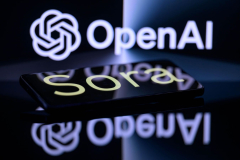
The Sora is being displayed on a smartphone with the OpenAI logo visible
NurPhoto via Getty Images
Shrek and baby Shrek taking a stroll through the White House. Sponge-Bob at Walmart. Mario and Luigi riding elephants through the gardens of Versailles.
What all of these have in common is their ability to be cleverly rendered by Sora 2, the latest iteration of OpenAI’s image-generation engine. The possibilities are practically endless. So now we have more complex, full-featured image and video generation, greater deepfakes potential and a new app for sharing. What could go wrong?
A lot, according to many viewers who are already sort of turned off by what they call “AI slop.”
Another related term is “brain rot,” or, what happens when someone spends too much time watching boring, mediocre, unchallenging content.
Let’s look at that first adjective — boring. The ideas like those above are not classically boring; they’re outrageous. But in their arbitrary parading, they may, in fact, become boring. And that’s just part of what has people worried about Sora 2. There’s already been great controversy over whether AI can learn from creative material made by other AI, and then generate a result that’s up to a human standard. Now we get to see what all of this is like on steroids.
The Race to Meme Vending
Let’s take a step back for a little background.
When Sora 1 came out, the response was lackluster. Google Veo ended up stealing a lot of its thunder.
“AI video has been Google’s playground for months, thanks to its Veo 3 model quietly spreading across Gemini, YouTube, and Workspace,” Vyom Ramani wrote at Digit.in. “But with the September 2025 launch of Sora 2, OpenAI has finally caught up to Google in AI video generation and it has done so with a splash. Sora 2 arrives not just as a technical model but as a social app, signaling OpenAI’s intent to compete head-on for creators’ attention.”
Indeed, it’s the social app, and the features, that are creating some of the concerns. The sharing app could springboard more of the “AI slop” to the front of the line and lead to a kind of malaise in a new generation of users jaded by that endless parade. But there’s more. Through the platform’s Cameos feature, users can drop themselves or others into videos and basically deepfake real people at the drop of a hat.
Watch Your Friends
To OpenAI’s disclaimer that it will only let you deepfake someone who’s added you as a friend, let’s think about this. The original friending feature on Facebook lets friends see private profiles with things that users have created themselves. It does not let friends take personal images and data in private and do whatever they want with them. So choosing a “friend” on a platform like this is fundamentally different. How much should you trust someone to give them license to make the digital “you” do whatever comes into their heads?
“At the heart of the app is the ‘cameos’ feature, a powerful tool that lets users inject their likeness into videos,” Markus Kasanmascheff wrote at Winbuzzer. “This immediately brings the issue of deepfakes and consent to the forefront, with some experts warning it is a ’deepfake ticking time bomb’. While the feature is designed for personal use, critics worry the technology could be repurposed for malicious deepfakes or misinformation.”
From the Top
Sam Altman’s





